Back to the past - Incinerator plan causing alarm
- Published Date
- 21/05/2021
- News Topic
- Planning & Development
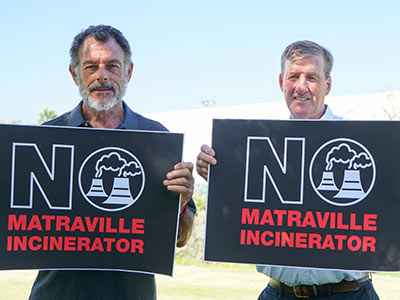
A proposal by one of Sydney’s biggest waste disposal companies to burn their rubbish at a Matraville paper mill has locals up in arms - and they have a warning for greater Sydney.
Ask anybody what they love about Matraville and the answer is usually the community.
It’s a tight-knit area full of families, kindergartens and a vibrant town centre.
“I call this area the hub of the universe. Where else would I want to live, everything is so close,” says former test cricketer and TV personality Mike Whitney.
Mike grew up in Patterson Street and says he’s seen the area change for the better.
“It was just such a wonderful place to grow up. But what we didn’t know back in those days was that we were actually living in a very toxic environment. There was an oil refinery, the Bunnerong Power Station, a papermill, a chemical factory called ICI and we didn’t realise it but there were heavy pollutants in the area.”
Fast forward a few decades and things are very different. The power station and old Hurley Crescent incinerator are gone, the residential population has increased significantly and governments at all levels have invested in cleaning up the area.
“But when I heard they wanted to build an incinerator in the area I couldn’t believe it,” says Whitney. “Isn’t it a backward step? Isn’t it going back to where we were decades ago instead of moving forward?”
In 2019 waste company Suez teamed up with the Opal paper mill (formerly Orora) on Botany Road and lodged a proposal with the NSW Department of Planning, Industry and Environment to build an incinerator.
Their plan is to burn 165,000 tonnes of waste a year at the Matraville paper mill trucked in from western Sydney tips to create energy to help power the mill.
The proposal is classified as State Significant meaning it has been taken out of the hands of Randwick Council and will be determined by the State Government.
The plan is still current and it’s suspected that Suez will lodge an Environmental Impact Statement to progress the application this year.
Not surprisingly, it’s got Randwick Mayor Danny Said concerned.
“The community here is more like a country town, everyone knows each other," he says. "Over the years the industrial nature has changed and this has helped the area’s sense of community shine.
“This community does not deserve a 17-storey high stack – as high as the Sydney Opera House – belting out fumes 24/7. The community does not want it and it just does not make sense,” says Mayor Said.
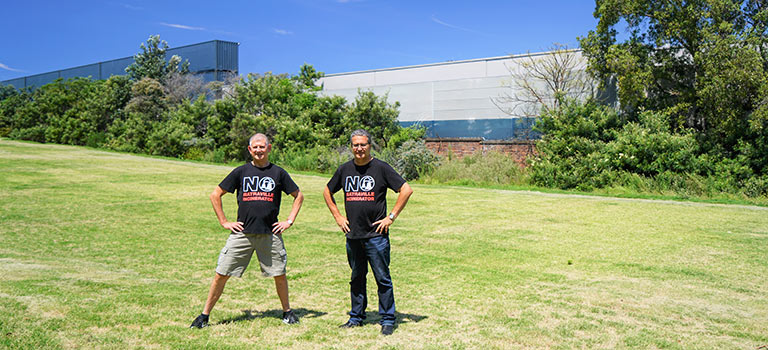 It’s a view shared by many others in the community too, including all three levels of government representatives from Mayor Danny Said to State Member Michael Daley and Federal Member Matt Thistlethwaite.
It’s a view shared by many others in the community too, including all three levels of government representatives from Mayor Danny Said to State Member Michael Daley and Federal Member Matt Thistlethwaite.
And the community is not taking the matter lying down.
A resident action group called No More Incinerators has started up and is actively opposing the plan.
The group is headed by Little Bay resident and chemical engineer Chris Hanson. Chris has spent most of his working life trying to clean up the pollution created by heavy industry at Port Botany.
“I was in Noel’s chemist shop at Matraville recently and he showed me a flyer about this incinerator plan. I took one look at it and thought ‘here we go again’. We’ve just cleaned up the area and we’re going to start all over again.”
From there Chris started the No More Incinerators group and is working closely with the Matraville Precinct.
“The most important message I want to get out to people is that this is going to affect all of Randwick City, not just Matraville. Even though it is a ‘modern’ incinerator where things are filtered out, pollutants are still present and we’re going to be exposed to them 24/7.”
Chris says the incinerator will burn selected waste (what Suez calls ‘processed engineered fuels’) which is basically processed waste from residential kerbside clean-ups and other non-recyclable waste including plastic, tapes and straps from the paper mill.
He says when these materials are burnt, they emit dangerous dioxins into the environment which can be breathed in and enter people’s bloodstream where they do not break down1.
Overseas studies have found that dioxins found in chicken eggs and breast milk have been linked with birth defects2. And all this is being burnt just 130 metres from people’s homes which has got locals upset.
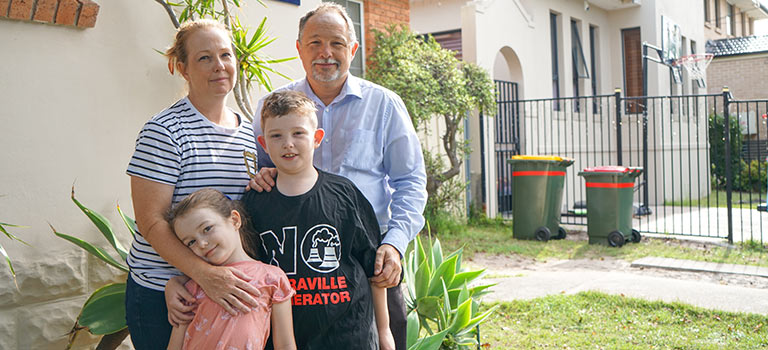
Mike and Amanda Pollak who live with their two children on Australia Avenue say it’s mind boggling to think the proposal could even be considered.
“What I don’t get is it’s not just our area, it’s going to affect the whole Sydney basin,” says Mike.
“I’m asthmatic as well, so I can’t imagine what it’s going to do to me once it goes up, I am very scared,” says Amanda. “Think of our kids, we don’t want them growing up in this area if this is what’s going to be built there.”
There are approximately 5,000 people who live within one kilometre of the proposed site and over half a million people living within a 10-kilometre radius.
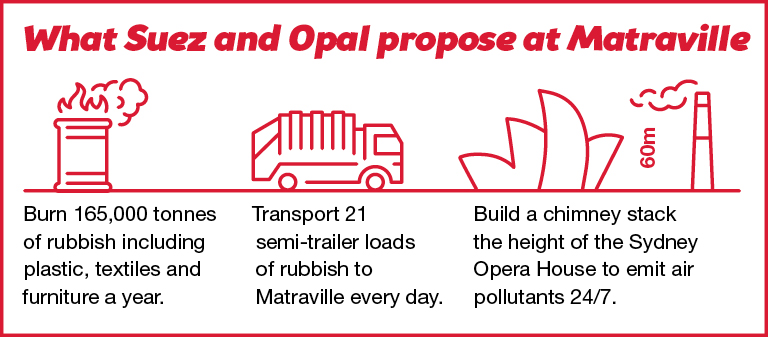
Source: Suez Scoping Report 2 Sept 2019, page (i), p20, p ii)
- page (i) The Project seeks to construct and operate a Cogeneration Plant firing approximately 165,000 tonnes per annum (tpa) of fuel, to supply reliable and secure energy for the Orora Recycled Paper Mill.
- p20 A 60 m vent stack
- p (ii) PEF delivery from Chullora plant via trucks (approximately 21 per day).
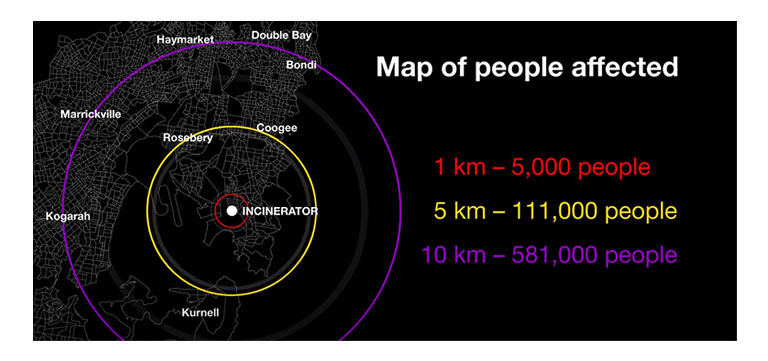
Source: Randwick City Council GIS Department. Estimated population based on SA1 boundaries.
Chris says initial modelling shows the plume emitted from the 60-metre high chimney would be blown by prevailing winds over most of greater Sydney.
Football great Russell Fairfax who also grew up in the area says he remembers as a child playing hide and seek at the paper mill on Botany Road.
“My message is the people must come first. If they burn rubbish, it’s going to affect the whole area and I have concerns about that because there are more people living in this area than ever before.”
Long-time local Gary Leafe has lived on the same street his whole life which is just metres from the proposed incinerator.
“When the Bunnerong Power Station was torn down 30 years ago, I thought the suburb was going forward, now I’m starting to wonder if the suburb is going backwards. At least with the power station you knew what they were burning, it was coal, with this, we don’t even know what’s going to be burnt here, how can that be good?”
What can you do about it?
- Visit nomoreincinerators.com and get involved in the community campaign.
- Visit No More Incinerators Facebook page
- View the proposal as lodged on the NSW Government Major Project website
References
[1] Arkenbout, Abel, Petrlik, Jindrich, 2019/08/26, Hidden emissions of UPOPs: Case study of a waste incinerator in the Netherlands
[2] Peiwei Xu, et al. (2019) High intake of persistent organic pollutants generated by a municipal waste incinerator by breastfed infants, Environmental Pollution 250 (2019), 662–668
